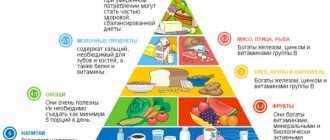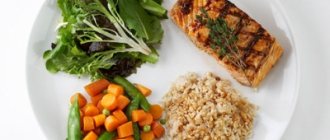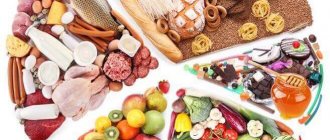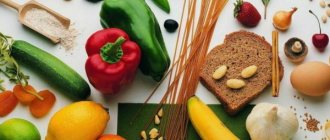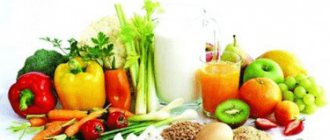Hello readers of my blog. Today I want to continue the topic of proper nutrition, started in this article.
I have also already talked about the components of proper nutrition and the importance of balancing them.
Here, I want to talk about another fact that needs to be taken into account when compiling our daily menu - the compatibility of products for proper nutrition.
Eating compatible foods will help our body fully absorb the nutrients of a particular product.
How does this happen?
All food products have a different chemical composition, which of course affects their “digestibility” in our body: • this is the time that needs to be spent on digesting a certain group of products; • these are certain enzymes that process this food.
Let me explain this in a little more detail.
There are foods that are quickly digested, and there are foods that are slowly digested. If we consume them together, then food, which should quickly leave our body, will linger longer, the digestion process is disrupted - the food is not digested, but simply rots or ferments!
For example, an apple eaten at work (as a snack) leaves the stomach within half an hour. If we “snack” an apple after potatoes and meat (it takes more than 4 hours to digest), then it remains with these “slow” products and after 30 minutes it is already completely fermented.
In addition, a particular product in the stomach requires a different environment. So meat needs an acidic environment, and potatoes are “processed” into an alkaline environment.
The large intestine is also involved in all this. In it, food is no longer “processed” by our enzymes, but by our microorganisms - bacteria.
Let's roughly divide them into good and bad.
The good ones increase our immunity, help us “absorb” vitamins, process fiber, fight bad bacteria, etc.
Bad ones are all sorts of pathogenic microorganisms that are always present in our body. But some even help - they fight our “wrong” food, help quickly process it and remove it from the body.
So - raw plant food is processed by our well-wishers - beneficial bacteria, and the more and longer we consume such food, the more of them and the stronger our immunity becomes. And when we mix food - meat with salad, then a war begins in the intestines (and the consequences are gases) of who will win.
Therefore, it is very important for us to know how to properly combine foods with proper nutrition so that digestion time, enzymes, etc. more or less coincided, and there will be no imbalance in the process of their processing, because this is the basis of a healthy lifestyle .
Of course, we don’t know what we process with what, and what is combined with what.
But there was a doctor, Herbert Shelton, who offered us his table of food compatibility for proper nutrition.
There are controversial points in this table that modern scientists criticize (we know how they feel about everything that contradicts their dogmas). Of course, we cannot determine the correctness of all combinations of products, so whether to believe or not is up to you.
And further. You can always check with your body, and it will always tell you whether you have chosen the right combination or not.
How to Use a Food Combination Chart
The highlighted color means: Green cell – compatible products. Yellow - can be combined. Red – incompatible products.
For example, let’s look at how butter and bread combine. Butter - No. 3, bread - No. 7. We look at the intersection of No. 3 with No. 7 - we see green, ideal. That is, these are compatible products.
The essence of separate nutrition
Foods have different chemical compositions, which affects the rate of digestion in the body. For example, fruits are digested in 30 minutes, and meat in 6-8 hours. The main goal of separate nutrition is to organize the consumption of foods with different periods of digestion at different meals.
According to supporters of this system, food that is delayed longer than expected can cause adverse processes in the gastrointestinal tract. In addition, it is assumed that foods that require different enzymes for digestion should be separated, because otherwise the food may not be digested and will lose its value.
Explanation of some products from the table
No. 8. Tomatoes and sour fruits These are tomatoes and fruits that have acid - currants, strawberries, pineapples, pomegranates, strawberries, limes, tangerines, grapefruits and oranges.
No. 9. Semi-acidic fruits These include - quince, grapes, gooseberries and raspberries, blackberries, blueberries, cherries, gooseberries, nectarines and peaches, pears and apples, plums and apricots
No. 10. Sweet fruits These are figs, bananas, dried fruits, mangoes, persimmons, etc.
No. 11. Non-starchy vegetables Brussels cabbage, white cabbage and cauliflower, broccoli, parsnips, celery, sorrel, cucumbers, eggplant, lettuce, peppers (sweet), rutabaga. Sprouts: wheat, barley, alfalfa, etc.
No. 12. Starchy vegetables Artichoke, beans, carrots, corn, peanuts* Jerusalem artichoke, peas, potatoes, pumpkin.
* Peanuts, lentils, legumes and all grains combine both protein and starch.
Proper nutrition: what goes with what
Modern nutritionists and naturopathic doctors have much in common in their understanding of healthy eating:
- You need to be able to combine products correctly, for example, cereals can be combined with vegetables, but flour products should not be consumed with sweets;
- The share of fresh vegetables and fruits in the diet should be more than 50%;
- You need to chew food slowly and be sure to listen to the feeling of fullness;
- You need to eat in moderation and maintain high physical activity;
- The last meal should be 4-6 hours before bedtime;
- You need to exclude any refined foods, fast food and table salt from your diet;
- You can’t go to stores on an empty stomach;
- It is advisable to stick to two meals a day.
Scheme of the optimal combination of food products according to G. Shelton
Rules for healthy eating according to Ayurveda
To get a complete understanding of the rules of nutrition and a healthy lifestyle, let us turn to the ancient texts of Yoga and the Vedas. Thus, Ayurveda says:
The nutritional rules of each person are individual and depend on his nature, innate constitution, metabolic rate, life goals and personal duty to society.
Ayurveda contains knowledge about how, with the help of certain nutritional rules, you can influence the state of a person’s body and mind. According to this text, the body's constitution is determined by the balance of three physical energies called Doshas: Vata ('Wind'), Pitta ('Bile') and Kapha ('Mucus'). It is believed that health is in order when all three Doshas are balanced with each other. For example, a person with a predominance of Kapha is a person with a slow metabolism and suffering from excess weight. To restore health, such a person needs to eat foods that reduce Kapha and increase Pitta and Vata.
Ayurveda also explains what nutrition is required for different activities and also relates a person's activities to the nature of his thoughts. A person's thoughts can be in one of three states: goodness (Sattva), passion (Rajas) and ignorance (Tamas). For example, a person who is in a state of Rajas is very active, impulsive and may take hasty actions. In the state of Sattva, a person is calm and reasonable. In a state of Tamas, he is indifferent and lazy.
Foods of goodness include: cereals, legumes, nuts, honey, cereals, fruits, dairy products.
Passion foods include: spicy foods, onions, garlic, tea, coffee, fried foods.
Foods of ignorance include: highly fatty or highly sweet foods, spoiled or old foods, refined foods, alcohol, white flour, meat products, fish and eggs.
Through a certain combination of food products, Ayurveda allows you to regulate both the mental state and the constitution of the human body. For example, for a person engaged in spiritual practices, it is necessary to eat sattvic food, and if such a person has an active metabolism, sattvic food must be combined with food that increases Pitta Dosha, i.e., slows down the metabolism. Another example: if a person who is active and active by nature experiences apathy or laziness at some point in his life, then he may need to eat rajasic foods in combination with foods that restore the balance of his Doshas.
Despite the individual approach to human health in Ayurveda, there are a number of general universal rules for healthy eating:
- Fruits are best eaten separately from other foods;
- Rice and other grains go well with vegetables;
- It is permissible to consume dairy products (buttermilk, yogurt, kefir) with cereals and vegetables;
- Honey should not be heated; when heated, it acquires toxic properties;
- Milk is not consumed together with vegetables, legumes, sour fruits and fermented milk products;
- Water should be drunk at least half an hour before meals;
- It is advisable to prepare food in a state of calm and peace of mind
Nutrition: the right combination
To summarize the review of the rules of healthy eating, we note that all nutrition rules come down to one thing - food should be easily absorbed by the body, bring maximum benefit without causing harm to the body.
According to G. Shelton, food products can be divided into proteins, vegetables and herbs, starchy vegetables, sweet fruits, sour fruits, starches, fats and sugars. Let us consider the following product groups separately and determine the appropriate optimal combinations with them. Food combination scheme according to G. Shelton
PROTEINS
Protein products include:
- lentils, chickpeas, beans, peas, beans, soybeans and other pulses;
- cheese, cottage cheese and other dairy products;
- nuts and seeds;
- avocado;
- mushrooms.
The easiest and healthiest combination of proteins with other foods is a combination of proteins with vegetables and herbs. Protein foods can be consumed together with fats. A harmful combination with proteins is the consumption of heavy starchy foods with them, such as cereals, flour products and starchy vegetables.
Pulses as a source of vegetable protein go well with herbs and non-starchy vegetables. However, legumes also contain concentrated starches, so they can be combined with fats, especially easy to digest ones - vegetable oil or sour cream.
Cottage cheese is a hard-to-digest complete protein. It is permissible to combine fermented milk products with fat, such as sour cream and cream.
Due to their rich fat content, nuts are similar to cheese. However, cheese contains animal fats, and nuts contain easily digestible vegetable fats. The most acceptable cheeses are young cheeses like homemade ones, that is, something between cottage cheese and cheese.
It is worth mentioning milk separately. Milk is a separate food and should not be classified as a drink that can be drunk like water. Once in the stomach, the milk must curdle under the influence of acidic juices. If there is other food in the stomach, then the milk particles envelop it and isolate it from the gastric juice. Until the curdled milk is digested, the food remains unprocessed, rots, and the digestion process is significantly delayed.
SALAD LEAVES AND NON-STARCH VEGETABLES
Vegetables are usually divided into low-starch and starchy.
Non-starchy and low-starch vegetables include:
- parsley, dill, coriander and celery;
- spinach, arugula, romaine, leaf lettuce, iceberg, radish tops, beets, wild “table” herbs and other tops of all edible plants;
- white cabbage, broccoli, asparagus, green peas;
- bell peppers, cucumbers, tomatoes, pickled tomatoes and cucumbers, onions, garlic;
- eggplants, zucchini, radishes, rutabaga, radishes and turnips.
Leaf salads, greens and non-starchy vegetables are the most versatile foods in terms of compatibility with other foods. They go well with grains, legumes, cheeses and oils. It is known that acids and oils help absorb micro- and macroelements contained in green lettuce leaves. As a separate food, leafy salads can be consumed with a small amount of natural apple cider vinegar and cold-pressed vegetable oils.
Tomatoes stand out among non-starchy vegetables; they have a high content of acids - citric, malic and oxalic. Lettuce salads, green vegetables and avocados go well with tomatoes.
STARCH VEGETABLES
Starchy vegetables include:
- potatoes, pumpkin, beets, carrots;
- parsley and celery roots, horseradish.
Starchy vegetables are perfectly digestible with herbs, non-starchy vegetables, vegetable oils, butter or sour cream. You can also eat baked starchy vegetables on their own. Their combination with kefir is acceptable. Combinations with legumes and other starchy and protein foods are considered harmful. The combination of starchy vegetables with sugars is also harmful, since mixing any starches and sugar causes fermentation in the intestines.
SWEET AND SOUR FRUIT
Sour fruits include:
- all citrus fruits (oranges, grapefruits, lemons, limes), pineapples and pomegranates;
- sour apples and peaches, sour grapes and plums;
- sour berries: currants, lingonberries, cranberries, sour cherries.
Sweet fruits include:
- bananas, sweet grapes, sweet apples and pears, persimmons;
- dates, figs;
- sweet berries, dried fruits.
Fruits, especially sweet ones, should be digested as a separate food, and it is recommended to consume them at least 20–30 minutes before meals, and not after meals, so that fermentation processes do not occur in the intestines. For example, first you can eat a couple of bananas and after half an hour you can eat a full lunch.
In small quantities, a combination of sour fruits with cottage cheese, milk and nuts is acceptable. Note that melons, such as watermelons and melons, are also eaten as a separate dish. Sour fruits are better digested separately from sweet fruits, so it is not recommended to mix them with sweet fruits.
STARCHES
Starches in the form of cereals and porridges are the basis of nutrition for most people on our planet. However, all foods rich in starch should always be treated with great care, because starch itself in its pure form is an extremely difficult to digest product. In this regard, perhaps the most important law of separate nutrition is the ban on combining starchy foods with proteins and other types of starch.
Starches can be divided into gluten-rich (gluten-containing) and gluten-free (gluten-free) starches.
Gluten-free starches include:
- buckwheat,
- rice,
- corn,
- amaranth, quinoa, millet,
- beans, beans, peas, lentils, soybeans, corn.
Gluten-containing starches include:
- wheat, rye, spelt, spelled,
- oats, barley,
- whole grain wheat or rye bread.
Starches can be combined with fats, especially those that are easy to digest - vegetable oil and sour cream. Porridge goes well with butter. However, adding sugar (or honey) to porridge is detrimental to the health of the intestinal microflora, as it causes fermentation and the development of pathogenic microflora. Therefore, it is harmful to consume cereals, porridges, flour products and any other starches with sweet foods, including honey and dried fruits. A combination of porridges, cereals and other starchy foods with sour fruits, berries and tomatoes is harmful.
Note that bread should be a separate meal (maybe together with butter), and not a mandatory addition to every meal. However, bread made from unrefined, whole grains can be eaten with various salads, regardless of their composition.
FATS
Fatty foods include:
- flaxseed, rapeseed, olive, sunflower, corn, sesame and other vegetable oils;
- butter, cream and sour cream;
- avocado, olives;
- hazelnuts, pine and other fatty nuts;
- seeds.
As mentioned above, oils and other fatty foods go well with lettuce, tomatoes and other vegetables. Fats also make a good combination with cereals, porridges and all other foods containing starch. The combination of fats with protein products is acceptable, but not optimal, since fats slow down the process of protein absorption.
It is worth noting that vegetable oils can be useful if they are produced from environmentally friendly seeds, are cold-pressed oils, are consumed in moderation and in raw, unrefined form. Vegetable oils can provide real benefits if they contain an optimal ratio between omega-3 and omega-6 fatty acids. These oils include flaxseed, rapeseed and olive oils.
SAHARA
Sugars include:
- honey, agave nectar, stevia;
- dates, figs;
- raisins and other dried fruits.
Any sugars are single foods and should be consumed separately from other foods.
Honey is a very healthy product, but you should observe moderation in its consumption, like any other product with a high sugar content. Honey is good to use in herbal decoctions along with lemon juice during periods of body cleansing or therapeutic fasting.
It is worth noting that confectionery and any other products of mixing sugars and starches poison the human body. All sugars inhibit the secretion of gastric juice. Neither saliva nor gastric juice are needed to digest them: they are absorbed directly in the intestines. If sweets are eaten with other foods, then, lingering in the stomach for a long time, the sugars very soon cause fermentation in it. Confectionery products and refined sugar should be completely excluded from your diet.
WATER
Water is a single product that is not recommended to be consumed during or after meals. Washing down food with water or any other drink reduces the concentration of gastric juice and slows down digestion. The optimal time to take water is half an hour or an hour before meals.
Advantages of separate power supply
The diet is based on the consumption of natural products with minimal processing. Semi-finished products, fast food, sugar are not recommended. Those. the body receives only useful substances that saturate well, while the caloric content of the diet is reduced, which promotes weight loss.
The selection of products is carried out consciously and thoughtfully, which develops the skill of meal planning.
It is not difficult to formulate a diet; many foods are allowed, from which it is easy to prepare delicious dishes. When switching to this regime, no radical changes in eating habits are required.
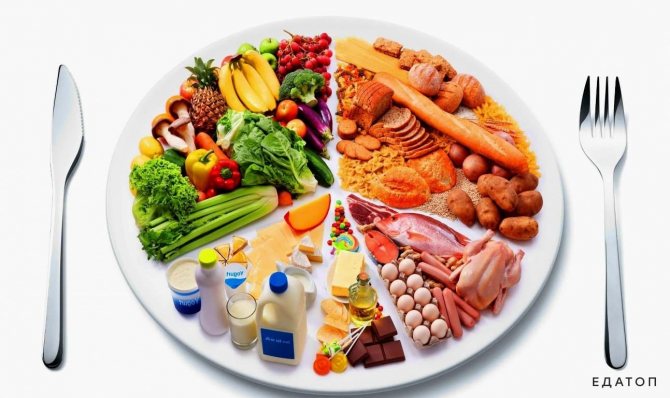
With separate meals, most foods are allowed to be consumed.
Experts' opinions
As early as 1935, Stuart Baxter showed that the pancreas secretes digestive enzymes simultaneously, regardless of whether the food eaten is carbohydrate or protein.
Elena Chedia, a nutritionist of the highest category at the Clinic of the Institute of Nutrition of the Russian Academy of Medical Sciences, points out that nutritionists are extremely skeptical about separate nutrition. She writes that the attempt to explain the rationality of separate nutrition by the processes of fermentation and rotting that occur when different types of products are combined is far from reality. With normal functioning of the gastrointestinal tract and the absence of enzyme deficiency, no “rotting” is possible. If there is any disease, it must be treated either with special diets or medications, and the human stomach is formed so as to digest mixed food, and not its individual types in turn.
A detailed criticism of the separate nutrition system was given by L. S. Vasilevskaya, Doctor of Medical Sciences, Professor of the Research Institute of Nutrition of the Russian Academy of Medical Sciences, leading specialist of the Russian Federation in the physiology of nutrition and digestion. Vasilevskaya notes that the hypotheses underlying the separate nutrition system do not agree with the data obtained over many years by medical science (research by I. P. Razenkov (1948), A. D. Sineshchekov (1970), G. K. Shlygin ( 1989, 1997), HN Munro (1970) and other physiologists). Endogenous proteins of the body are constantly secreted into the digestive system, which, in addition to their enzymatic function, act as suppliers of amino acids. Thanks to this process, the amino acid composition of chyme is equalized. Consequently, with separate nutrition, the body has to constantly produce additional secretions to correct the composition of the chyme in order to ensure normal absorption of nutrients from the intestines, which is an additional burden on the gastrointestinal tract and the entire body. According to L. S. Vasilevskaya, the assumption that various enzymes inhibit each other, not promoting better digestion, is refuted by research data.
L. S. Vasilevskaya also notes that G. Shelton’s concept does not take into account the centuries-old habits of people to consume mixed foods. Over the course of many generations, the development of enzymatic adaptation to familiar food is observed, which leads to rapid and optimal homeostasis of functions in the body.
German nutritionist Karina Pohes characterizes the Hay-Shelton system as follows: “Scientifically, this is complete nonsense, since the body is able to process both proteins and carbohydrates at the same time.”
Doctor of Medical Sciences, Head of the Department of Metabolic Diseases of the Research Institute of Nutrition of the Russian Academy of Medical Sciences Yu. P. Popova believes: “The doctrine of separate nutrition has no scientific basis.”
American nutritionist T. Freumin classifies all types of separate nutrition as persistent myths about health. She points out that in fact, there is not a single correct statement in the theory of separate nutrition. Combining foods in itself does not affect the level of acidity in the gastrointestinal tract, and the ability to digest and absorb protein does not depend at all on which foods are digested at the same time.
K.b. n. physiologist R. S. Minvaleev claims that there is simply no serious theoretical justification for the concept of separate nutrition, and calls Herbert Shelton “ignorant in elementary issues of gastroenterology.” According to him, Shelton had a very rough idea of the existence between the stomach and the small intestine of the duodenum, in which proteins (by the pancreatic enzyme trypsin and other proteinases), fats (by lipases with the participation of hepatic and cystic bile) and carbohydrates (various amylases) are simultaneously digested ), that is, there is simply no “separate” digestion, at least in the duodenum. Minvaleev also notes that the pleasure hormone serotonin is produced with a mixed diet, but not with a separate diet. Thus, separate nutrition leads to prolonged unmotivated depression, and in this case, a return to a mixed diet can replace antidepressants.
The theory of separate consumption of “carbohydrates” and “proteins” is considered unfounded also because it ignores the fact that all carbohydrate-rich foods contain significant amounts of protein.
Experts point out that only a combination of different products best ensures that the body receives the nutrients it needs from food; With a wide variety of substances, it is easier for the body to “select” the necessary ones. The processes of assimilation and metabolism of microcomponents are often sharply activated in the presence of other nutrients. The most favorable from the point of view of the “work” of all enzymes of pancreatic juice is the intake of the most varied food containing optimal ratios of proteins, fats and carbohydrates, in which the body simultaneously receives amino acids, fatty acids, and monosaccharides, that is, building material and energy carriers . The entry into the blood of only “building material” without energy and, conversely, energy without “building material”, undoubtedly creates difficulties for the body
Alcohol and caffeine
The classic situation: you drink a couple of glasses of wine with dinner, you start to feel sleepy, and to cheer yourself up, you drink a cup of coffee. This is a very, very bad idea, and here's why. The burst of energy you get from caffeine masks alcohol intoxication, preventing you from being in control of your condition. The same can be said about cocktails like whiskey and cola or vodka and red bull. In addition, the body receives too contradictory messages from the substances it absorbs. On the one hand, you relax him with alcohol, on the other, you force him to be alert with the help of caffeine.
We eat fruits separately!

Fruits often act as dessert. They are light and leave a pleasant aftertaste. But hot dishes eaten before fruit take much longer to digest. Therefore, the fruit begins to rot in the stomach. You cannot refuse them. Fruit intake should be postponed to a later date. For example, 40 minutes after eating.
Combining fats with fruits and vegetables
Fat-containing foods include animal and vegetable oils, sour cream, cream, lard, fatty fish and nuts. The peculiarity of fats is that when they enter the stomach, they slow down the secretion of gastric juice. This property is even more noticeable if you eat something fatty at the very beginning of the meal. As a result, food stagnates in the stomach and the entire digestion process slows down. Hence the heaviness in the stomach, nausea, and unpleasant belching. To prevent this from happening, it is useful to combine fats with herbs and vegetables from the first and second groups. It is also possible to combine fatty foods with starchy vegetables and some fruits. You can combine berries, such as strawberries, with heavy cream on one plate. But in this case, you should not add sugar to the dish.

